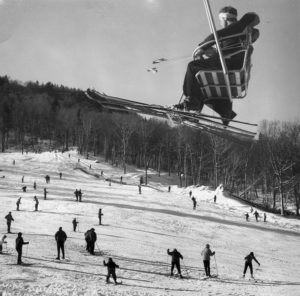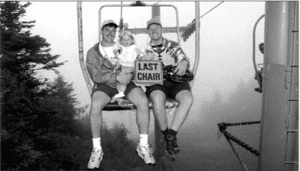Killington chairlifts through the decades tell a tale of challenges overcome, improved experiences
By Karen D. Lorentz
The decommissioning of the K-1 Base Lodge, which began after a final “tear down party” on March 20, 2022, was the last step in the transformation of the Killington K-1 base area to the thoroughly modern base worthy of a world-class resort.
Juxtapose that to the ski area’s humble beginnings. It had opened on Dec. 13, 1958, with a temporary base lodge, an outhouse, and two Pomalifts. Two more Pomas debuted by the end of Jan. 1959, one a gentle “baby” Poma for the novice area by the base lodge and the other in the glades area.

First Killington chair overlooked the expanded novice slope and the gentle “baby” Poma, in what’s now know as the K-1 base area. Photo circa 1961.
Killington had such a shoestring start that a ski instructor who was helping to start the Stratton Ski Area had contemptuously exclaimed on a 1960 visit to the area, “a bunch of amateurs.” Seeing the unpainted double chairlift and debris lying around, he had called Killington “the least impressive of all the areas visited.”
That unfinished look was due to a challenging installation, but it wasn’t for a lack of vision. While Killington founder Pres Smith had planned for a gondola to go up Killington Peak, the reality was he couldn’t find the money and had settled for a chairlift. (The ski industry was too new, making financial backing hard to find.)
While Stratton had hired a helicopter to install its first chairlift in 1961, Killington workers installed chairlift towers with the aid of a crane. (A helicopter strong enough for lift installation hadn’t been found prior to Stratton where someone “knew someone” who knew about heavy duty ‘copters that worked on oil rigs.)
Challenges to building the first chairlift
In March 1959, Killington applied to the Vermont Development Credit Corporation (VDCC) for a $50,000 loan to facilitate building its first chairlift. This was the second time a VDCC loan was sought.
The first loan was sought to help get Killington started and had been rejected. (Stowe’s Sepp Ruschp had investigated Killington for the VDCC Board and reported that the Killington undertaking would never succeed and said the credit corporation shouldn’t risk its money on such a chancy proposition.)
The second application was submitted when Ruschp was taking a ski vacation in Europe, and sponsors of the $50,000 loan application were able to gain approval in his absence.
However, it was coupled with conditions requiring Killington to raise additional funds through the sale of stock. A Rutland banker on the board who had opposed the loan was satisfied with the conditional approval because he was confident they wouldn’t succeed in selling enough stock.
But it did.
Killington’s second stock offering to raise $120,000 (480 shares at $250 each) was made on April 3, 1959. The first chairlift was ordered from J. Pomagalski and Cie on June 15. Designed, engineered, and manufactured in France, the chair cost $77,300 and could deliver 750 rides per hour to Killington Peak. The VDCC granted the loan on June 26, 1959.
The summer of 1959 saw a lift line cut and two trails carved off the summit of Killington peak, the steep Cascade trail and the easier Goat Path which meandered over to the glades area (now North Ridge) and connected to Snowdon trails — a trail now known as Great Northern.
The Killington chairlift, which was to have operated by the end of 1959, arrived on Thanksgiving Day. It was 6,300-foot-long and the first chairlift Smith had ever built.
“We were doing things on a shoestring and had elected to build the chair with our own crew. It was a learning process, from learning how to read blueprints to building all the footings and putting all the pieces together. We did pretty well except I don’t think I did a very good job in planning out the time,” Smith said in a 1988 interview.
The cold weather and abundant snowfalls made progress difficult. They were aligning the towers with five to six feet of snow on the ground causing the men to dig down to attach each of the four legs on the lattice towers to their foundations.
By the time the lift operated 13 feet of snow covered upper mountain trees as well as the large Army surplus trailer that was used to haul materials up the mountain. Two tractors drove over it without even knowing it!
The new lift began operations in March, just three weekends before the ski season ended. Ironically, the chairlift proved its worth that summer, carrying almost 5,000 visitors to the peak from June to October.
Fast forward
In 1975 the first Killington chair was replaced with a new Hall manufactured double. It had an unusual 1,500-rides per hour capacity, making it one of the most productive double chairs in existence. It also loaded at an unusual 4.7 second rate (between riders) just as the first one had! (A triple chair was not installed because at the time, there wasn’t one with gearbox components capable of accommodating the extreme vertical and length of the lift.)
An important improvement to the new chairlift was the use of the first D/C drive. It allowed a variable cable speed, which was helpful for extreme wind conditions and for running the chair at slower speeds for visitors in summer.
In 1976 the original Killington chair was rebuilt and became the Needles Eye double. Its capacity was upgraded to 1,350 rides per hour as new components were added. Its lattice towers stood testament to earlier times until an express quad replaced it in 1996.
On Aug. 17, 1997, the Hall chairlift was decommissioned in a ceremony that paid homage to the demise of the famous fast doubles that served the main mountain for so long.
To honor the occasion, Killington sponsored an Ode to the K-chair contest. Mark English, a four-year veteran ski pro at Killington and a “liftie” on the K-chair the summer of 1996, was one of the winners. He had been the first one on the chair when the area opened on Oct. 4, 1996 and shared the last ride on Aug. 17, 1997 in addition to taking home a K-chair.

Rich Hargrave (l) and Mark English (r) arrived at Killington Peak on the last chair K-Chair Aug. 17, 1996. It was replaced with a quad.
The other winner was Rich Hargrave of Brewster, New York. He met his wife at Killington in 1989 and noted the area had been “a big part of our lives.” He had plans to hang the chair at his house where it could continue to remind them of their history and the area.
As they sat on the last chair to the peak, taps played in a salute to the chair’s history of transporting skiers, snowboarders, bikers, hikers and tourists to New England’s highest lift-serviced summit.
“Mark and I got chills when we heard taps. It gave me goose bumps. It was a sad occasion but at the same time it’s progress,” Hargrave had commented.
It was also a fulfillment of Pres Smith’s original dream for reaching Killington Peak with a gondola. It was Les Otten — whose American Skiing Company had purchased Killington’s parent company in 1996 —who replaced the double with the K-1 gondola.
The K-1 gondola was installed — with its base area located to the right of the base lodge — in 84 days by its manufacturer, Poma of America. Several updates since have included new cabins and a storage barn.
With the construction of the nearby Alpine Training Center in 1974, the installation of the Supestar Quad in 1987, the K-1 gondola in 1996, and the completion of the new K-1 Lodge slated for this November 2022, Killington Resort will provide a modern updated base area and the “better experience” that the founders sought to provide. It will also fulfill the vision of today’s resort leaders and owner Powdr to transform the way guests experience and enjoy Killington.




